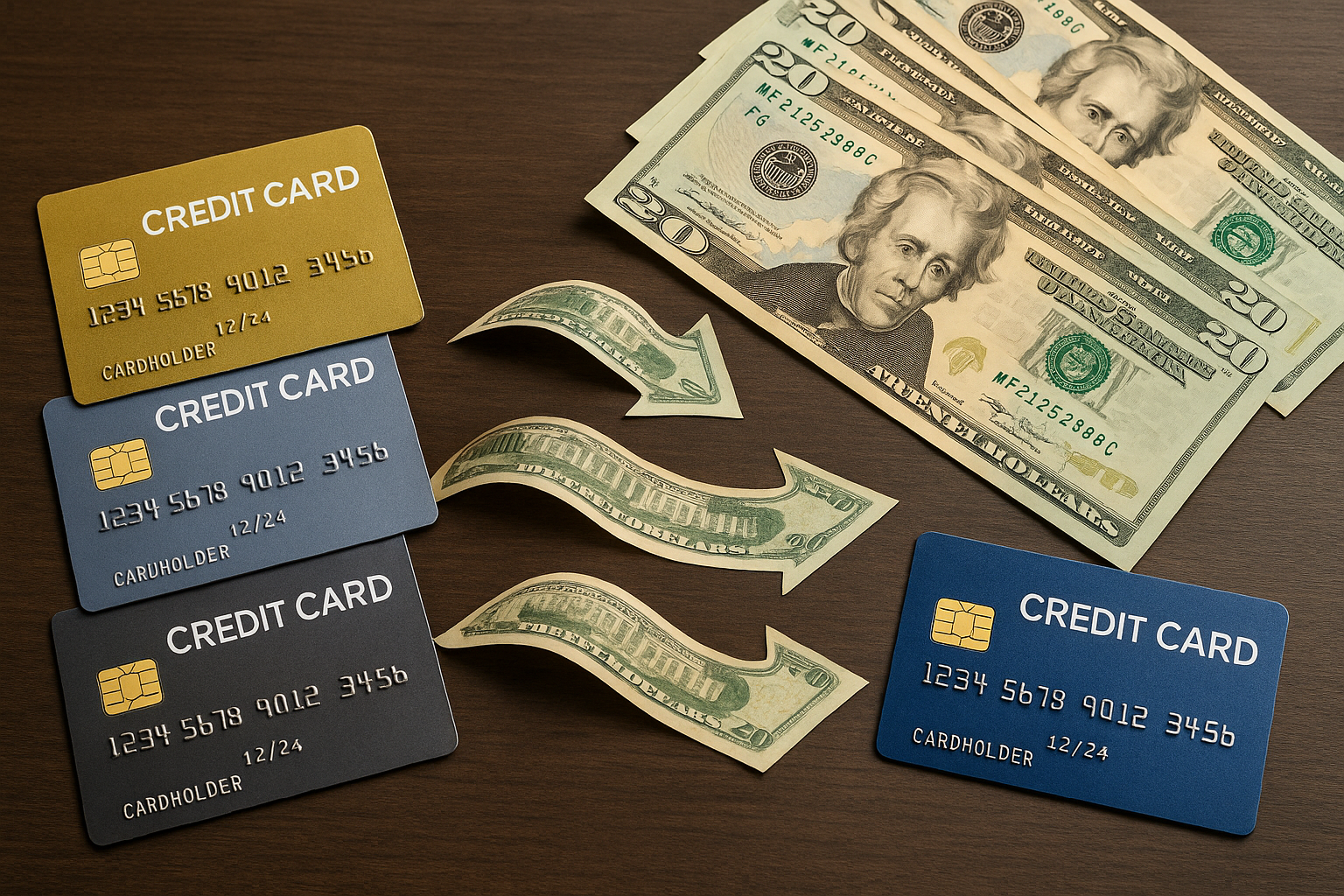How do balance transfer credit cards work? Are you struggling with credit card debt and looking for a way to save money on interest? If so, a balance transfer credit card might help. These cards allow you to move existing balances from one card to another, often with a 0% introductory period on interest charges.
However, while balance transfer cards can provide breathing room, they don’t provide free money. Used correctly, they can help you pay down debt faster. Used incorrectly, they may leave you worse off. Here’s how they work and how to decide if one could be right for you.
Key Takeaways
|
What Is a Balance Transfer Credit Card?
A balance transfer credit card lets you shift debt from one or more credit card accounts onto a single card. The best options have a promotional period, in which you can avoid paying interest charges for a set time, usually between 6 and 21 months.
These cards typically require good to excellent credit scores, which means not everyone will qualify. Though some credit cards for good credit do offer excellent intro deals, including low-cost transfers.
If you can find one that matches your credit profile, the potential to save on interest is significant, even taking into account the obligatory balance transfer fee that typically applies.
Related Article: How Many Credit Cards Should I Have?
How Do Balance Transfer Credit Cards Work?
Balance transfer credit cards do pretty much precisely what the name says they do. These products provide a low-cost way to pay off or, at least, pay down debt quickly. They work best for consolidating smaller balances that you’re sure you can manage before the intro term ends.
Keep in mind that these cards aren’t necessarily a cure-all. You’ll need discipline to ensure you follow the terms to get the best results. However, they can be powerful tools for saving interest money quickly.
Here’s the process for using them successfully:
- Search for a balance transfer card option that you qualify for, and that offers an appealing 0% APR offer with a timeline that matches or exceeds how long you’ll need to pay off the transferred amount.
- Apply for the card using a prequalification tool that most of the best balance transfer cards offer online. Using this tool won’t impact your credit score or appear on your report.
- Choose which debts to move.
- Accept the transfer fee, typically ranging from 3% to 5% of the total amount, when making the transfers. Fees will be added to your new card balance.
- Make payments consistently and on time, in an amount that ensures the balance will be paid off before the end of the intro period. Failing to make on-time payments can result in penalty fees.
Balance Transfer Fees
So, what are balance transfer fees?
The Consumer Financial Protection Bureau (CFPB) explains:
“A balance transfer fee is a fee charged to transfer an outstanding balance to a different credit card. A credit card company is permitted to charge you a balance transfer fee on a zero percent rate offer.”
Because you’ll pay no interest on your balance, all of your payments will go toward paying down your principal. To make a profit, the new card provider charges a fee for the convenience. This is where the “no free money” aspect comes into play.
For that reason, even with a 0% APR introductory period, make sure the savings outweigh the cost of the transfer fees before committing to the new card offer.
A Word of CautionOur on-staff Certified Financial Educator stresses that balance transfers only work successfully if you treat them as a structured repayment plan, and not as free or easy money. Without discipline, the savings from a 0% APR period can diminish quickly once the regular APR kicks in after the intro. Worse, failing to make a payment during the intro period is costly, as you’ll likely lose your intro offer and could pay penalty interest on the balance. |
Related Article: Can Credit Cards or Personal Loans Help Pay Off Medical Debt?
Are Balance Transfer Cards Worth It?
Not every financial tool works equally well for everyone, and balance transfer credit cards are no exception. Whether they’re worth it depends largely on how you discipline yourself to make the necessary payments, the size of your debt transfers, your overall financial outlook, and your ability to pay off the debt within the introductory period.
For some, these cards can quickly save hundreds of dollars in interest and provide serious debt-consolidation results. For others, they can create more problems if used without a clear plan.
Related Article: How Can I Lower My Credit-Card Interest Rate?
The Case For Balance Transfer Cards
The biggest advantage is the chance to save money on interest while consolidating debt. If you can pay off your balance during the promotional period, you can make major progress in reducing your overall debt load.
Dana Yao, a Co-founder at Dana Yao Media, has experienced success with balance transfer credit cards and says this regarding whether she thinks they’re worth it:
“They’re worth it if you know what you’re doing, are aware of your ability to pay back, and have clear financial goals.
In my example, it was worth it because I had a repayment plan and didn’t rack up new debt at the same time. That saved me the interest fees I otherwise would have paid on the high-APR card. It also works well for large purchases that need to be paid off gradually.
On the other hand, they’re not worth it if you only pay the minimums or use the card as a crutch for overspending.
Bottom line: they’re best for disciplined payers who can clear debt during the 0% interest period. But they clearly aren’t magic fixes for ongoing spending problems or for people without a plan to pay it off before the low-interest period ends.”
Dana adds notes about her experience when using balance transfer cards for travel expenses:
“We take big trips and usually come back with some debt. With some planning, a balance transfer card helps consolidate that debt and gives us breathing room to pay it off without the interest.
But this should not be your way to ‘fund’ a trip…it’s more of a recovery method than a planning tool.”
The Case Against Balance Transfer Cards
While powerful, these cards aren’t without their drawbacks:
- Balance transfer fees can eat into your total savings. Take care to ensure the costs don’t outweigh the savings.
- After the introductory period, the APR often jumps higher than your old card if you’re not careful to choose the right offer.
- You typically need a strong credit score to qualify.
- Only making the minimum monthly payment defeats the purpose.
Pitfalls to Avoid
Charles Hoff, AFC and Member Financial Education Counselor at DFCU Financial, offers this statement as a warning to avoid taking on a balance transfer card without planning ahead, along with solid, simple advice to protect yourself.
“If you’ve done a balance transfer to take advantage of a lower or 0% promotional rate, be sure to make your payments on time or risk losing that low rate. Many people don’t realize that if you’re late, the issuer can retroactively apply the higher standard interest rate to your balance.
To avoid this costly mistake, I recommend setting up automatic payments from your checking account to ensure you never miss a due date.”
How Do Balance Transfer Credit Cards Work?
Tips for Using Balance Transfer Cards Effectively
Here are a few ways to get the most out of using a new balance transfer credit card to help consolidate debt.
- Pay more than the minimum monthly payment to cut debt faster.
- Pay off your balance before the introductory period ends to avoid high interest charges.
- Don’t add new charges while you’re working down the balance.
- Compare balance transfer offers carefully before committing. A 5% transfer fee may not be worth it if your balance is small.
- Keep an eye on your credit score. Applying for new credit can cause a slight dip, but consistent on-time payments help you recover. Apply for just one card at a time to manage hard inquiries on your credit report.
Balance Transfer Credit Card Alternatives
While balance transfers can be helpful, they aren’t the only way to tackle credit card debt. If you don’t qualify for a 0% APR balance transfer offer, or if you have larger balances that may take longer than the promotional period to pay off, a personal loan or debt consolidation loan can be a smart alternative.
The best personal loans generally come with fixed interest rates, predictable monthly payments, and repayment terms that give you more time to get your debt under control. The best debt consolidation loans often offer direct payments to creditors, simplifying the process.
If you’re considering one of these options, compare lenders carefully to find the best rates and terms for your situation. Online marketplaces like Credible make the process easier by showing multiple offers side by side and allowing you to prequalify without affecting your credit score.

